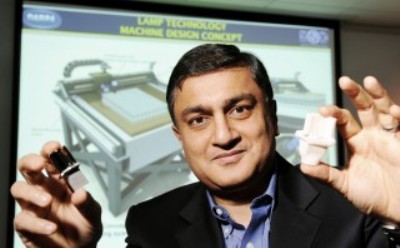A team led by Suman Das, a professor in Georgia Tech’s School of Mechanical Engineering, has designed an innovative, all-digital casting process that enables production of a metal part directly from a computer-aided design (CAD).
 Suman Das, a professor in Georgia Tech’s School of Mechanical Engineering, displays a ceramic mold produced directly from digital designs using large area maskless photopolymerization (LAMP) technology.
Suman Das, a professor in Georgia Tech’s School of Mechanical Engineering, displays a ceramic mold produced directly from digital designs using large area maskless photopolymerization (LAMP) technology.
The process has the potential to enable highly cost-effective and efficient manufacturing procedures methods after a part shifts to mass production and to allow faster prototype development time.
The novel method focuses on a process called investment casting or lost-wax casting, where a part is created by pouring molten metal into an expendable ceramic mold. Investment casting is utilized to produce precision parts in various industries, including electronics, biomedical, energy and aerospace. At present, nearly all precision metal castings are designed using CAD software, noted Das. However, the next step is to create the ceramic mold, which can be used to cast a part. This involves a series of six major procedures that require hundreds of tooling pieces and costly precision-machined dies. Thus, it is a costly method that produces several defective molds, as well as waste parts before creating a useable prototype.
Large area maskless photopolymerization (LAMP) technology is a high-resolution digital process developed by Das and his team, which involves a device that makes ceramic molds from CAD designs. The process arranges 100-micron layers one over another to form the mold. Then, the cured resin is removed and the left over ceramic is sintered in a furnace. This results in a complete ceramic mold into which molten metal like titanium-based alloys and nickel-based superalloys are poured to produce a more accurate casting. The team is confident that their approach can decrease costs by at least 25%, minimize the number of waste parts by over 90% and eliminate 100% of the tooling.